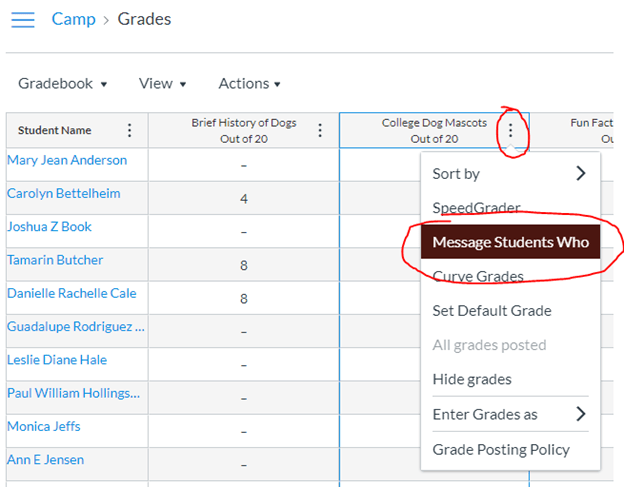When I taught my second large lecture class, I was struck by how much I missed getting to know my students. Preoccupied with creating the course the first time around, my students being right there in front of me was enough. But the second time, I saw that I didn’t have time to get to know them. I tried to learn the names in my gradebook, but this was just a nod to a relationship. I knew I wouldn’t even manage to connect those names with a face for most of those students. (I know some of you pull that off, and you inspire me!)
Building relationships with our students is important. Relationships not only improve student engagement but also reduce academic dishonesty. They foster dialog about our lives and our academic disciplines. They inspire us to learn even as we teach. For so many reasons, we need to connect with our students.
One way to connect with lots of individual students quickly is to use Canvas to Message Students Who. This feature lets you send messages to each of the students in your course who meet a certain criterion. Did something happen in your life, and you’re behind on grading half of the students’ assignments? Drop a note to the students whose assignments you haven’t graded yet. Worried that your freshmen students might forget that quiz due tonight at midnight? Send a reminder to the students who haven’t taken it yet. Know that the students who got a D on their essay are unlikely to pass the class without an intervention? Invite them to office hours. Through Message Students Who, you send one message. But each student receives it individually to start a one-on-one conversation with you.
Two instructors, Lindy Kosmitis and Terry Bertling, tried this out in Grammar for Journalists, a required, large-enrollment course. Students who earned an A or B on an important quiz got an encouraging note. Terri and Lindy sent C students extra resources to review. And they asked students who struggled, earning only a D or F, to come to office hours. Here’s how some students responded to their messages:
“Thank you so much for your encouragement. I do normally struggle with grammar so I’m trying to get a lot out of this course. Thanks for taking the time to commend your students.”
“Thank you so much for this email. It’s nice to know that professors actually pay attention to students individually. (lol) I did feel a little rusty when it came to subject verb agreement. I will definitely take a look at the link you sent me, and thank you for the advice. I’ll be sure to review this topic.”
“Thank you so much! I appreciate you taking the time to send me a website to review as well.”
All quotes are from Mass Communications students in Spring 2020.
Want to try it? You can find Message Students Who in three places in Canvas. That sounds confusing, but they are in context, pretty much right where you want them to be. Take a look at to whom you can send messages and from where. Let us know if you try it!
Quizzes
 Figure 1 Use Message Students Who tool in Quizzes.
Figure 1 Use Message Students Who tool in Quizzes.
Message students who…
- Have taken the quiz
- Have NOT taken the quiz
Grades
 Figure 2 Message Students Who tool in Grades.
Figure 2 Message Students Who tool in Grades.
Note: The above example is taking from a mock course. All ‘students’ shown are ODEL staff members.
Message students who…
- Haven’t submitted yet
- Haven’t been graded
- Scored less than
- Scored more than
New Analytics
 Figure 3 Message Students Who tool in New Analytics.
Figure 3 Message Students Who tool in New Analytics.
Course Grade view or Student view
Message students who…
- Score Range
- Missing
- Late
Weekly Online Activity view
Message students who…
- Viewed
- Didn’t View
- Participated
- Didn’t Participate
Thanks for sharing that Message Students Who may not work smoothly with McGraw-Hill. There certainly can be bugs when connecting more than one piece of software together, and testing with a peer is often a good idea. I’m sorry you had a difficult experience.
For those of you using just Canvas, however, you’re certainly in the clear. And I’ll leave a reminder that on all of the Message Student Who screens, you can see a list of the students that meet the criteria and that Canvas will send messages to. Use that as a quick check.
I actually tried this in my Canvas class at the beginning of the semester. On day 3 of week two, I sent a message to all students that had not started working in the class. The criteria was based on zeros in the Canvas gradebook.
The result was disaster. 430 emails were sent, one to every student – not the 50 who had not started working. How did this happen? I use a third party simulator application that connects to Canvas feeding grades into the Canvas gradebook. What NO ONE at TxState or Canvas or McGraw-Hill knew is that Canvas fails with this task because grades are not generated WITHIN Canvas.
My advice is a note of caution for using this tool because it is only effective for assignments that are created and completed within Canvas.